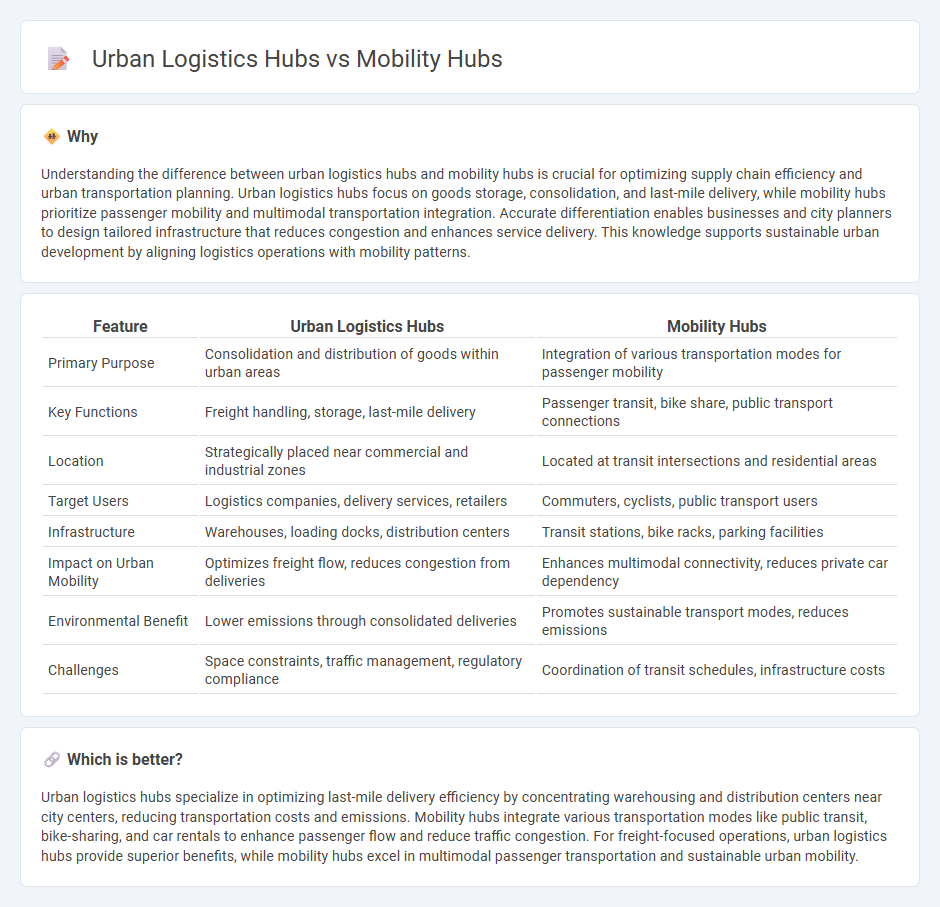
Urban logistics hubs streamline the distribution of goods within city centers by optimizing storage, transportation, and delivery processes to reduce congestion and emissions. Mobility hubs integrate various transportation modes, such as public transit, bike-sharing, and ride services, to enhance urban mobility and accessibility. Discover how these hubs transform urban living and commerce by exploring their distinct roles and benefits.
Why it is important
Understanding the difference between urban logistics hubs and mobility hubs is crucial for optimizing supply chain efficiency and urban transportation planning. Urban logistics hubs focus on goods storage, consolidation, and last-mile delivery, while mobility hubs prioritize passenger mobility and multimodal transportation integration. Accurate differentiation enables businesses and city planners to design tailored infrastructure that reduces congestion and enhances service delivery. This knowledge supports sustainable urban development by aligning logistics operations with mobility patterns.
Comparison Table
| Feature | Urban Logistics Hubs | Mobility Hubs |
|---|---|---|
| Primary Purpose | Consolidation and distribution of goods within urban areas | Integration of various transportation modes for passenger mobility |
| Key Functions | Freight handling, storage, last-mile delivery | Passenger transit, bike share, public transport connections |
| Location | Strategically placed near commercial and industrial zones | Located at transit intersections and residential areas |
| Target Users | Logistics companies, delivery services, retailers | Commuters, cyclists, public transport users |
| Infrastructure | Warehouses, loading docks, distribution centers | Transit stations, bike racks, parking facilities |
| Impact on Urban Mobility | Optimizes freight flow, reduces congestion from deliveries | Enhances multimodal connectivity, reduces private car dependency |
| Environmental Benefit | Lower emissions through consolidated deliveries | Promotes sustainable transport modes, reduces emissions |
| Challenges | Space constraints, traffic management, regulatory compliance | Coordination of transit schedules, infrastructure costs |
Which is better?
Urban logistics hubs specialize in optimizing last-mile delivery efficiency by concentrating warehousing and distribution centers near city centers, reducing transportation costs and emissions. Mobility hubs integrate various transportation modes like public transit, bike-sharing, and car rentals to enhance passenger flow and reduce traffic congestion. For freight-focused operations, urban logistics hubs provide superior benefits, while mobility hubs excel in multimodal passenger transportation and sustainable urban mobility.
Connection
Urban logistics hubs streamline the storage and distribution of goods within city centers, reducing delivery times and congestion. Mobility hubs integrate multiple transportation modes, facilitating efficient passenger transfers and supporting last-mile deliveries. The connection between these hubs enhances urban supply chain efficiency by linking goods movement with accessible transit options, promoting sustainable and timely logistics operations.
Key Terms
Intermodal Connectivity
Mobility hubs integrate multiple transportation modes such as buses, trains, bicycles, and ride-sharing to enhance seamless urban mobility, while urban logistics hubs optimize freight distribution with intermodal connections to reduce delivery times and congestion. These hubs leverage intermodal connectivity to streamline passenger transfers and facilitate efficient goods movement, maximizing urban space utility and minimizing environmental impact. Explore detailed analyses of how mobility and urban logistics hubs shape sustainable city infrastructure.
Last-Mile Delivery
Mobility hubs integrate various transport modes to facilitate passenger movement while urban logistics hubs concentrate on streamlining last-mile delivery by optimizing storage, sorting, and distribution close to end consumers. Last-mile delivery benefits from urban logistics hubs through reduced congestion, faster delivery times, and improved sustainability via electric vehicle use and consolidated shipments. Explore our detailed analysis to understand how these hubs shape efficient urban goods movement and passenger transit.
Consolidation Centers
Mobility hubs integrate various transportation modes to facilitate passenger movement, while urban logistics hubs focus on optimizing freight distribution within cities. Consolidation centers play a critical role in urban logistics by aggregating goods from multiple suppliers, reducing delivery trips and emissions in dense urban areas. Explore how consolidation centers enhance efficiency and sustainability in urban freight management.
Source and External Links
Mobility Hubs - Urban Design Studio - Mobility hubs are focal points in transportation networks integrating multiple modes (bus, bike share, car share, etc.) with amenities like real-time info, bike repair, and Wi-Fi to enhance first-mile/last-mile connectivity and flexibility for future growth around transit stations.
Mobility Hubs - SANDAG - Mobility hubs combine transit with shared mobility services and technology to provide seamless, accessible travel options, supporting connections to jobs and activity centers, and are projected to serve a large share of population including vulnerable groups by 2050.
Mobility Hubs: The Future of Multimodal Transportation in Cities - Mobility hubs enhance urban transportation by integrating public, shared, and active modes with amenities like real-time info, secure bike storage, and EV charging, offering improved accessibility, reduced traffic congestion, and environmental benefits.
 dowidth.com
dowidth.com